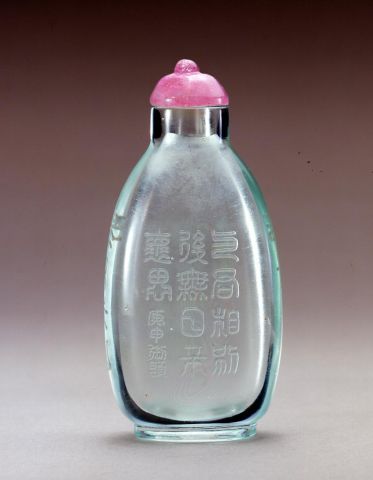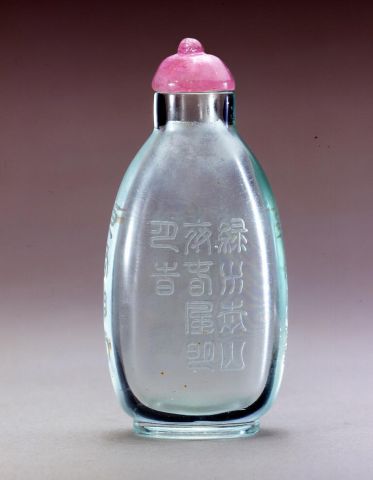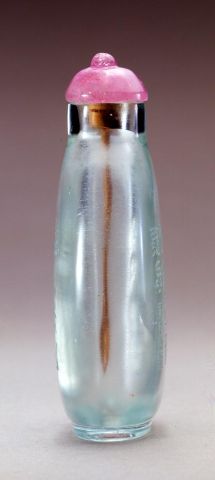


Bottle ID: 00389
AQUAMARINE, IMITATION, CARVED W/POEM
Date: 1740
Height: 68 mm
Glass, transparent aquamarine tone, of elongated form with sloping shoulders and a well-carved footrim; incised on each main side in stylized archaic script with a ten-character poem; one side with the characters 'yuti' (imperial inscription) and a cyclical date 'gengshen' (1740).
The first side inscribed:
"Nights of green waters and blue mountains,
A time of spring breezes and bright moonlight".
The second side inscribed:
"After we parted there is
Not a day I do not think of you".
"Written by His Majesty in the year gengshen".
Imperial, attributed to the Palace Workshops, Beijing.
Similar Examples:
Sotheby's New York, September 15, 1998, lot 256, The Neal W. and Frances R. Hunter Collection.
Provenance:
Clare Lawrence Ltd.
The Monimar Collection
Clare Lawrence Ltd.
Joseph Baruch Silver
Clare Lawrence Ltd.
Sydney L. Moss Ltd.
Exhibited:
Annual Convention ICSBS Toronto, October 2007
Annual Convention ICSBS Hong Kong, October 1996
Christie's, St. James's, London, June 1996
Published:
Lawrence, Clare. Miniature Masterpieces from the Middle Kingdom - The Monimar Collection of Chinese Snuff Bottles, 1996, pp. 230-231. no. 109.186
During the eighteenth century, glass blocks were transported from the glass factories in Boshan in Shandong Province to a number of different glass producing areas, including Beijing and specifically to the Palace Workshops. For the most part, these blocks of glass were melted down in large furnaces, with the molten liquid being used to produce the glass objects that exist in collections today. A very small group of glass snuff bottles do not appear to have been made in this way and it is possible that they were carved from solid blocks of glass. The Archives of the Zaobanchu mention that jade carvers were seconded to the glass workshops leading us to conclude that the ability to produce a high quality bottle, such as this example, using jade carving techniques was possible.
Although the color, weight and tactile qualities of this bottle incline us to think of it as imitating aquamarine, there are very few, if any, perfectly flawless bottles in this stone. In this case, it is far more likely that the color is itself a reference to the poem inscribed upon the "first" side of the bottle. "Green waters and blue mountains" may additionally refer to a painting of the Tang Dynasty which was known to be executed in the green/blue archaic style. That being said, the only similar example found which resembles this bottle is the aquamarine bottle from the Hunter Collection cited above.
The two couplets form a complete five-syllable quatrain. Despite the imperial nature of the inscription, this poem does not appear among the collected verses of either the Kangxi Emperor or the Qianlong Emperor. There is also a gengshen year during the reign of the Xianfeng Emperor but the bottle is unlikely to have been made at this time. Since the Qianlong Emperor writings were prolific, it is most likely that the poem can be attributed to him as the bottle itself appears to be eighteenth century. A Shoushan seal known to the translator of the inscription provides us with some intriguing information as it has the same poem on its face in different seal script.

 English
English 中文
中文